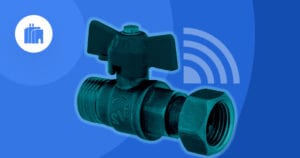
The need for reliable and timely data in construction and critical infrastructure management is clear. However, until recently, data collection for structural health monitoring (SHM) has mainly been a manual exercise where engineers have to go out in the field to make key measurements. The challenge of manual data collection is that it’s slow, unreliable and highly inefficient.
The emergence of the Internet of Things (IoT) is a shot in the arm to the civil and structural engineering industries. Significant reductions in the cost of sensors and connectivity, combined with the growth in platform-as-a-service business models, now make it possible to gather lots of data remotely, aggregate it and make critical analysis to generate actionable insights.
IoT is a concept of exposing data generated from points of operational interest. At the basic level, it seeks to improve situational awareness by enabling visualization of important field parameters. Structural health monitoring (SHM) is the process of monitoring or assessing the condition of a structure in order to gather information on its current state by tracking variables like vibration, strain, stress and other physical phenomena, responses and conditions. It seeks to assist in non-destructive evaluations aimed to detect location and extent of damage, calculate the remaining life of an asset and predict upcoming accidents.
As critical assets like bridges, dams and equipment are constructed and age, it becomes apparent for the owner or operator to ensure their safety and longevity. While non-destructive testing is standard practice in the assessment of structural integrity, the possibility to protect and monitor assets with IoT sensors offers asset owners the opportunity to extract value through artificial intelligence, mitigating financial and operational consequences of deterioration and routine manual supervision. Moreover, asset owners are offered the capability to predictably manage maintenance investment more effectively, minimizing downtime and avoiding, or carefully planning, costly repairs.
The idea behind SHM is to collect data from multiple sensors installed on structures in order to process and understand useful information about the current state of the structure for maintenance and safety purposes. The ability to monitor and track critical assets in order to improve operational effectiveness is one of the most important ways IoT can add value to an asset owner or operator. Sensors can be placed at critical locations on members of the structure and relay information to the cloud through LPWAN, BLE mesh or 5G networks. The SHM system provides data about the changes in a structure due to the aging of materials, environmental factors or accidental damage.
Typically, SHM systems are devoted to monitoring humidity, temperature, accelerations, tensile stress, compressive stress and building materials degradation. The methods used are non-invasive and require the deployment of sensors in checkpoints well defined by the professionals. The information from the sensors is merged with mathematical models to determine the safety of the structure.
Drivers for IoT Adoption in Structural Health Monitoring (SHM)
Structural health monitoring seeks to identify the possible existence of a risk or opportunity in an infrastructural asset. It has evolved from a topic of interest to researchers to a business case due to the proliferation of sensors and IoT capabilities. Below, we summarise how the adoption of IoT in SHM is creating value for asset owners.
Safety and Compliance
The prevalent use of the user pay principle due to public-private partnerships on critical infrastructure means that users deserve and can demand safe and available assets. As structures age, safety concerns escalate. While it used to be difficult to detect deterioration inside structures, IoT sensors now allow the gathering and analysis of data thus ensuring higher safety and security. Permanent and reliable information about the structure guarantees the safety of users, peace of mind and reputation of the provider.
Furthermore, it’s cost-effective to implement a mandatory monitoring system through IoT sensors that may be required by regulation for mission-critical assets like nuclear power plants in order to demonstrate safety.
Continuous Structural Monitoring
IoT sensors enable the supervision of a structure on a continuous basis in real-time. This is important in order to maintain functional utility, optimal performance and security. Maintenance scheduling becomes more focused. Monitoring is complementary to already existing methods to test and diagnose e.g. BeanAir, Roctest, SGS and Giatec. It’s also important to monitor structures during construction, commissioning, operation, refurbishment, alteration and even dismantling in order to discover deficiencies on time, reduce insurance costs and improve service availability. Some structures may require monitoring due to their innovative approach or use of special materials.
Extending Structural Lifetimes
Sometimes a structure approaches its design lifetime and there is a need to evaluate if it’s possible to postpone costly maintenance without risking structure deterioration. Real-time monitoring and analysis may be used to discover hidden structural reserves that allow for controlled lifetime extension. Moreover, due to inherent design considerations, it can be possible to increase operational safety margins in a controlled way without risking over-stretching the infrastructure. Latent lifetime or load bearing capabilities can be made available and improve the utility of the asset.
Sensors can also be employed to detect and track the evolution of a defect in a structure, while simultaneously recording its response to stress events and environmental conditions. Armed with this information, decision-makers can take informed steps to prevent a defect from worsening, safely extending the asset’s life and reducing the risk of failure.
Optimizing Operations
A centralized structural management system is very important, especially in cases where the asset is complex or many assets are involved. Having all the critical field information on important assets presented in a consolidated way enables optimal operation, maintenance and repair based on reliable and objective data. Modern approaches such as maintenance on demand are made possible. Bringing the physical structures online allows for digital twinning. Reliable field data helps in quality control and quality assurance during construction, operations, maintenance and repair thereby eliminating the hidden costs of poor quality and non-conformance.
Continuous Improvement
Gathering data increases knowledge about the structure which allows for innovative and better structural designs in future especially in cases where similar assets have to be deployed at a larger scale. Sensors enable optimization of the design aspects and elimination of weaknesses on time.
Connected assets also offer research-based benefits through easy data collection thereby enabling knowledge growth and transfer through simulation and publications.
Increased Asset Value
An asset that relies on leading-edge technologies to improve outcomes has more prestige and perceived value. In disaster-prone areas, this may be used to negotiate for reduced insurance costs and even environmental taxes.
Marketing Technical Advancement
Technology can be an instrument to innovate and acquire new customers, especially for forward-looking organizations that seek to stay at the forefront of self-disruption. Connected infrastructure improves marketability. In some cases, using IoT capabilities in a project may reassure the public after the failure of an asset, build public confidence and generate excitement for future use.
Conclusion
Major factors driving the growth of the structural health monitoring market include high capital investments for structural health monitoring across various industries, stringent environmental regulations pertaining to the sustainability of structures and a decrease in the cost of IoT sensors that decrease the cost of adoption in structural health monitoring systems, among others. Additionally, the evolution of AI and digital twinning is making the adoption of IoT in SHM ever more appealing.





 Related Podcast Episode
Related Podcast Episode




 Related Applications
Related Applications


 Latest IoT News
Latest IoT News










